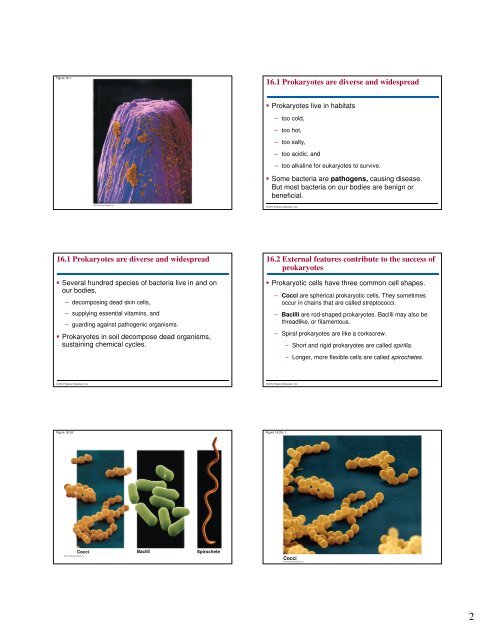Microbial Life: Prokaryotes and Protists - Renz Science
Microbial Life: Prokaryotes and Protists - Renz Science
Microbial Life: Prokaryotes and Protists - Renz Science
Create successful ePaper yourself
Turn your PDF publications into a flip-book with our unique Google optimized e-Paper software.
Figure 16.116.1 <strong>Prokaryotes</strong> are diverse <strong>and</strong> widespread <strong>Prokaryotes</strong> live in habitats– too cold,– too hot,– too salty,– too acidic, <strong>and</strong>– too alkaline for eukaryotes to survive. Some bacteria are pathogens, causing disease.But most bacteria on our bodies are benign orbeneficial.© 2012 Pearson Education, Inc.16.1 <strong>Prokaryotes</strong> are diverse <strong>and</strong> widespread Several hundred species of bacteria live in <strong>and</strong> onour bodies,– decomposing dead skin cells,– supplying essential vitamins, <strong>and</strong>– guarding against pathogenic organisms. <strong>Prokaryotes</strong> in soil decompose dead organisms,sustaining chemical cycles.16.2 External features contribute to the success ofprokaryotes Prokaryotic cells have three common cell shapes.– Cocci are spherical prokaryotic cells. They sometimesoccur in chains that are called streptococci.– Bacilli are rod-shaped prokaryotes. Bacilli may also bethreadlike, or filamentous.– Spiral prokaryotes are like a corkscrew.– Short <strong>and</strong> rigid prokaryotes are called spirilla.– Longer, more flexible cells are called spirochetes.© 2012 Pearson Education, Inc.© 2012 Pearson Education, Inc.Figure 16.2AFigure 16.2A_1Cocci Bacilli SpirocheteCocci2


